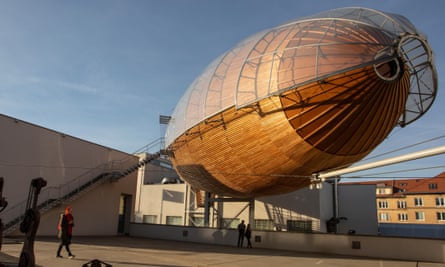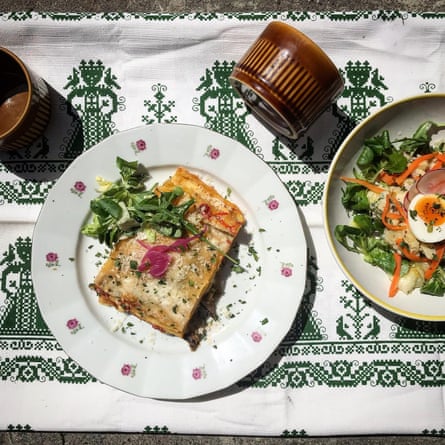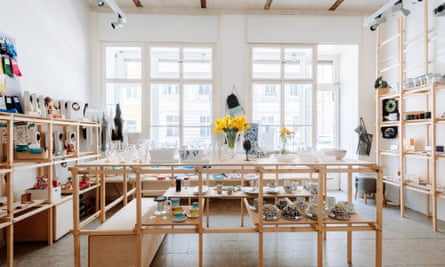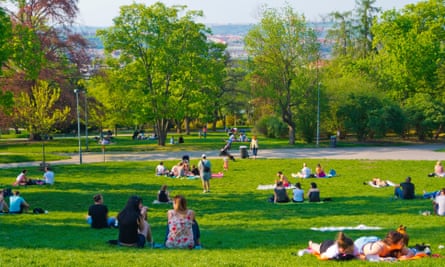Taste Georgian cuisine
Prague’s foodie scene is diversifying, with delicious Georgian cooking, which has a rising but still bafflingly low global profile, gaining popularity. Thankfully, the small but energetic local Georgian community is doing its bit to redress this injustice. At bustling Polévkárna Manana soup restaurant, the unstoppable owner, Manana Toidze, cooks a range of soups (a large bowl costs €3), including robust meat and walnut-based kharcho and international favourites, such as minestrone. Her compatriot, Lela Kukava, established nearby Fair Food Bistro, hidden in a quiet corner of the city centre. She employs refugees, who prepare their native dishes, and her homely restaurant also offers gluten-free and vegan options. Both eateries make good lunch choices and serve khachapuri, a highly addictive Georgian cheese-filled flatbread.
Polévkárna Manana: Bělehradská 77, on Facebook. Fair Food Bistro: U Nemocnice 4, fairfoodclub.cz, both open Mon-Fri
Airships and glassworks

The jumbo statements on the otherwise plain exterior of the DOX Centre for Contemporary Art are the only clue to the surprises inside. The critically acclaimed converted factory opened in 2008 and typifies the transformation of the post-industrial inner suburbs. DOX has quickly become a big hitter in the Prague art world, showcasing big local and international names. At the cafe terrace, get a close-up of the wooden zeppelin metres above. Attached to the building in 2016, the airship serves as a space for art and exhibitions. Internationally recognised Czech-born architect Eva Jiřičná, known for her use of glass and ethereal structures, is the subject of an exhibition running until August. Look out for the reconstruction of one of her signature glass staircases.
Adult £6.30, child £2, Poupětova 1, dox.cz, closed Tuesdays,
Food for body and soul

No bibliophile should miss friendly independent PageFive, a publisher and small bookshop specialising in culture, including publications on the Czech Republic, art, architecture and international works not found elsewhere in the country in English and Czech. English titles available include magazines and coffee-table architecture books, and there are also posters for sale. In the same street, Bistro 8 restaurant typifies a clutch of new eateries serving imaginatively prepared global cuisine. Many are found in inner suburbs such as Karlín and Vinohrady, where the other Bistro 8 is located. On working days, the restaurant offers an international soup and main course special, with dishes such as vegetable curry or pasta for around £7.50. At weekends, Bistro 8 does brunches.
PageFive, Veverkova 5, pagefive.com. Bistro 8, Veverkova 8, bistro8.cz
Escape to the country

For time out, head to Divoká Šárka valley, one of the parts of town untouched by post-1989 transformation. Catch tram 20 or 26 from Dejvická to the terminus for a change of scenery just metres from the airport road. Then, follow the walkers. Leave the bustle behind, enter the valley and follow the stream bubbling through a twisting canyon. The route continues past a popular open-air swimming pool, and the valley widens, a gentler landscape replacing the craggy drama. Finish at Jenerálka or Podbaba, both of which have handy bus connections to the metro.
Czech design

Design is thriving in the Czech Republic, boosted by international exposure. It can be purchased at self-explanatory Czech Design. The actual and online shops stock an eclectic and affordable selection of items, from greeting cards to ceramics, by leading and up-and-coming local designers. Look out for Libuše Niklová’s inflatable animal toys – retro classics from the 1970s – and minimalist Braasi backpacks.
Vojtěšská 3, czechdesign.cz , Mon-Fri
Browse at a market

Manifesto Market is a “village” made up of shipping containers, the brainchild of landscape architect Martin Barry. With international street food and night markets with DJs, the New Yorker’s project is helping to rejuvenate Florenc, once a neglected hub, east of the centre. From late November, the Florenc venue becomes an alternative Christmas market, a contemporary twist on seasonal celebrations.
Na Florenci, manifesto.city
Get a caffeine boost

Savvy young connoisseurs are invigorating the local bean scene. At Kavárna Místo and across the city, they’re challenging the central Viennese-style coffee houses. This cafe, which has outside seating in summer, has quickly become an institution. It also gathers plaudits for its filling breakfasts, including homemade pastries, fuelling some redemptive exercise in the ancient Stromovka Park nearby. The vast 100-hectare playground can easily accommodate huge numbers of regulars, from in-line skaters to cross-country skiers, yet never feels crowded. Close to the park is the recently restored Na Slamníku, a much-loved pub with a beer garden.
Bubenečská 12, mistoprovas.cz
Picnic with a panorama

Round off a visit with a picnic boasting the best view in town. The grassy expanses of Riegrovy Sady park are ideal for impromptu kickabouts and Frisbee hurling. They also make one of the most popular alfresco dining spots, and Prague Picnics can organise your food. Grab a spot on the north-facing slopes, which offer a spectacular panorama of the historic centre. Stretch out on a blanket, unpack the provisions, and join in the ritual of watching the sun slowly sink behind Prague Castle.
Access Riegrovy Sady park from Italská Street; Prague Picnics, Žitná 50, Praha 2, praguepicnics.cz, packs cost from €15 and can be delivered
Arts and craft beers

Before the 1989 Velvet Revolution, the Vysočany neighbourhood was known for its factory complexes. Many of them have been demolished or converted, notably the former Pragovka car plant. Now the Pragovka Art District, the space hosts regular exhibitions and events, and local artists hire the studio spaces. In the adjoining yard, craft beer lovers can quaff their way around the world at the Permanent Beer Fest, billed as central Europe’s biggest beer garden. Vysočany also occupies a place in Prague folk history. As the revolution snowballed, emboldened local factory workers downed tools and traded insults with boorish communist bigwigs, becoming local heroes.
Pragovka Art District: Kolbenova 34a, pragovka.com; Permanent Beer Fest: pbfest.cz, open Wed-Sun, on until September
Modernist masterpiece

Austrian modernist Adolf Loos designed Prague’s acclaimed cubic Villa Müller. But don’t forget his other local masterpiece (co-designed with Karel Lhota), the gleaming white Villa Winternitz perched high above town. The house is based on Raumplan principles – basically open-plan spaces on different levels. A Jewish family commissioned the villa, built in 1932, but sadly they only had a decade to enjoy it before being deported to Auschwitz, where some of the family perished. The surviving relatives never returned to or spoke about their home, which was returned to their descendants after 1989. The restored villa opened to visitors in 2017.
Adult entry £6.20, child £3.40, guided tours only (weekend only) £8.90, Na Cihlářce 10, loosovavila.cz, open Sun-Wed midday-6pm, closed Thu-Fri
Stay

The eco-friendly Mosaic House is central and offers both private and shared rooms at range of prices (basic doubles from £99 room-only in the high season).
When to go
Prague, long a favourite for weekend breaks, attracts visitors throughout the year, but early autumn and February and March are slightly quieter periods. What’s more, the city looks particularly magical as the leaves turn to gold or under a coating of snow in winter, when temperatures can drop well below zero. Summer festivals include Žižkovská Pivobraní beer festival (7-8 June, and the Bohemia Jazz Fest on Old Town Square (8-9 July).
Looking for a holiday with a difference? Browse Guardian Holidays to see a range of fantastic trips

Comments (…)
Sign in or create your Guardian account to join the discussion